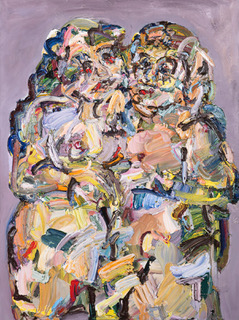
Touch
Artist: Vanessa Prager
Interview by Juan Marco Torres
Q: Can you share how you have achieved your characteristic impasto style of painting?
A: I was spending a lot of time in my old studio in Glendale trying to capture a feeling. It was a big warehouse with no windows so it left tons of wallspace – everything I had worked on in that last year or so was lined along those walls. Late one night in an hour of frustration, I took to reworking some old paintings. The figures started to disappear and re-emerge, then fade and blend together. Colors began melting into each other and lips of a portrait started to drip down the face. This, I thought, was real. It captured something I felt and sensed but could not put to words.
Q: What draws you from blending realism with texture abstraction?
A: I like to layer images. My mind is scattered and I like many styles. I want to merge multiple things together into a sort of melding pot. In my work, I am always trying new techniques and searching for new things and ways to incorporate them. A pattern I find, some aged fruit, flowers in my garden, a cakey lipstick – these are things I see and save to add to a painting where I think it is fitting.
Q: What kind of emotions do you seek to trigger with your work and why?
A: Often I put in a sort of pensive character or one that looks outward and inward at the same time. I don’t want the person to reflect the world around them so much as to move through the world and stay separate from it, if that makes sense. I hope my work will envelop multiple emotions as this is what I feel within any given period of time. We are often many personalities, some quite extreme, and we oscillate among these throughout a given day. Layering through images and textures helps me capture time.
Q: Which part of your creative process do you enjoy the most?
A: It can be difficult to work through a painting once it’s started, but there is also so much possibility then and so many ways it can go before it’s done. When I am working, I get lost and my mind is empty. I think I enjoy this period the most, although it’s also very fun to start a new work.
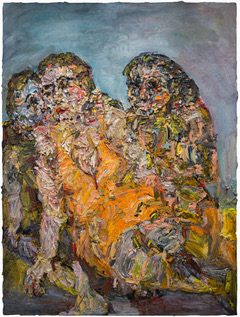
Bird Watching
Q: Your portrait of Maya Rudolph graced The New York Times Magazine cover back in September of 2018. The piece seems to reminisce about your earlier work. Can you tell me more about how your style evolved after that?
A: I was honored to paint Maya Rudolph and for this project it made sense to capture her this way – it was a surreal collaboration. There are a million ways to represent reality and that’s the best part about painting, sometimes it’s a slight shift that does the trick and this is one of those instances.
Q: Why did you choose figures of women as the subject of your Soft Serve pieces that were showcased in London?
A: I had been working on the Soft Serve series for a while in the background and foreground for a bit. I had to sort a few things out in terms of transferring my style to a new dimension. I was working more with broader strokes, bolder colors and some classical image references.
I had a very visceral dream in which I was murdered on a stormy night aboard a ship. Amidst feeling all of the sadness of death and the loss of my place, it suddenly switched and I was standing over myself, no longer me but the one who held the knife in hand. Both characters were very real while I was “playing them” and it got me thinking more about multiple characters and how different sides of things can be held within one thing. Being a woman myself I often paint what I know and I particularly love fleshy bodies. The groupings of one, two, three or more figures sort of melted together and converged, eventually becoming the body of work for Soft Serve.
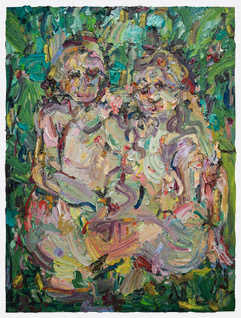
Low Hanging Fruit
Q: “Luncheon on the Grass” was one of my favorite pieces from your beautiful Soft Serve exhibit. Is there a particular story behind this painting?
A: This was titled after and slightly referencing the Manet painting “Le Dejeuner sur L’herbe”, but unlike the original where there is only one woman, I had a whole group of nude women. The figures themselves get lost on each other but the background is clearly cut making their shape unmistakably present. We had just entered the #metoo movement era and it stirred up a lot of activity all around. I loved the idea of solidarity and having each other’s back even in the most vulnerable positions. This painting was my ode to that chaos.
Q: I read in your interview with Paul Carter Robinson that some of your canvases weigh up to sixty pounds. How do your pieces become so heavy in the process?
A: Oil paint can be very heavy! I pile it on thick sometimes.
Q: How do you see the Los Angeles contemporary art scene evolving in the future?
A: With the current situation and even before COVID-19 I could see a lot more things moving online. Online studio visits allow more people to see into the practices of artists. Online shows and direct sales of work without having physically seen them first seems to be a new normal. Although I do hope the gallery experience is restored in a short time – there is nothing better than mounting an exhibition this way.
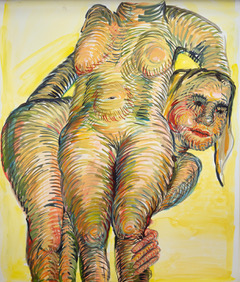
Peekaboo
Q: Are there any upcoming exhibitions we should be looking forward to?
A: I am about to be in a group show at Richard Heller gallery with a couple of recent drawings. I am also working toward a new show at The Hole.
Q: Can we expect to see any sculpture work in the near future?
A: Possibly! I am working on some freestanding sculptural works.
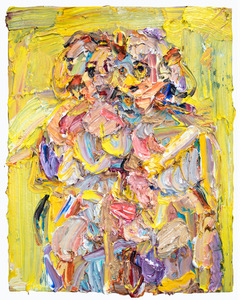
Sunday at Three